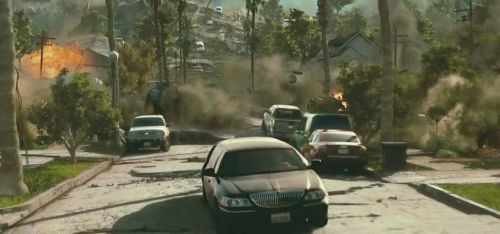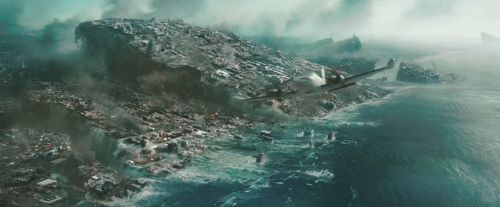2012 (Roland Emmerich, 2009)
In his book Ecology of Fear: Los Angeles and the Imagination of Disaster, Mike Davis notes the particular enthusiasm in popular culture for destroying Los Angeles, and categorises the different ways in which the city bites the dust. Nuclear weapons lead the way with 49 surveyed works. Earthquakes: 28 works. Invasion: 10. Monsters: 10. Pollution: 7. Gangs or terrorism: 6. Floods: 6. Plagues: 6… and so on. What nobody, so far, had seen fit to do was just tip Los Angeles over and throw it in the ocean.
Enter Roland Emmerich.
With his previous films Independence Day (1996), Godzilla (1998), and The Day After Tomorrow (2004), Emmerich has established himself as the king of the big budget disaster movie. The progress – such as it is – of Emmerich’s filmmaking is driven simply by the scope of his destruction: since the mid 1990s, when computer generated imagery first made carnage filmmaking of the Emmerich school possible, he has been incrementally ratcheting up the levels of devastation. In 2012 the earth’s core is liquefying, causing the continents to sink and throwing most of the world into the sea. Presumably 2012 is the last in this cycle, since all Emmerich can do from here is blow the Earth up, Death Star-style.
Inflation of scale is coupled with deflation of ambition: Emmerich’s career has been a prolonged exercise in lowering our expectations so that we accept what he dishes up without question. It works to a point. The destruction of Los Angeles at the end of 2012’s first hour is, indeed, one of those turn-off-your-brain-and-enjoy thrill rides that contemporary popular cinema is supposedly all about. The notion that blockbuster films serve up glorified theme park rides is frequently overstated, but it’s true of this sequence, in which characters careen through an obstacle course of flying vehicles, collapsing office towers, and exploding petrol stations. The sequence is so deliriously, ridiculously extreme in its destruction that you can’t help but be thrilled and amused. What’s more, it is undeniably well-staged: as chaotic as it gets, Emmerich orchestrates the calamity with a confidence befitting a veteran of the genre. Other moments, later in the film, have a similar audacity in their willingness to abandon all restraint, and hence take the film beyond all opportunity for either criticism or parody. When a giant tsunami, for example, overturns an aircraft carrier which then lands on top of the White House, it’s hard to do anything other then salute the man’s chutzpah.
But this is what I mean about lowered expectations. At best, 2012 is an amazing short film wrapped up in two hours of dull packaging: it’s one of those films where the trailer is actually the film’s preferred cut. When we talk about the thrill of the ride, or intellectualise the same point by musing about modern cinema’s return to an almost pre-narrative cinema of attractions, we’re in danger of becoming tone deaf to the differences between good and bad popular cinema. A number of better filmmakers have turned their attention to the disaster genre since the 1990s, and found interesting new angles on them: think Mars Attacks (Tim Burton, 1996); War of the Worlds (Steven Spielberg, 2007); or Cloverfield (Matt Reeves, 2008). None of those films are masterpieces, but they all recognise that the important parts of a genre film are not the familiar elements, but rather whatever points of difference a particular project can bring.
Points of difference, unfortunately, are not Emmerich’s strong point. His storytelling tricks are now so familiar that it has become embarrassing to watch him recycle them. The films in his disaster sequence have a standard structure that cuts between an everyman (here, it’s John Cusack) and the highest levels of American government. The President is noble and wise, but someone just below him in the power structure (here, a presidential adviser played by Oliver Platt) will be officious and improbably villainous. That person acts as a spoiler to the unfailingly right-on-target advice of a less senior authority figure (here a scientist, played with incongruous dignity and seriousness by Chiwotel Ejifor) who, coincidentally, is somehow an acquaintance of our everyman. There is a level of specificity in this recycling that is more grating than the re-use of more archetypal generic structures.
What’s more damaging in a cinema of spectacle is Emmerich’s inability to find new things to show us. The strongest aspect of Emmerich’s directorial style is his admirable devotion to clarity and his confidence in extremely large-scale choreography, and it is these traits that are impressively shown off during his destruction of Los Angeles. Yet at more simple levels of craftsmanship he is notably lacking. He rarely finds an interesting new way of staging action, which means his films are stitched together from tricks he has seen elsewhere or tried before (or seen elsewhere and tried before). When he comes up with an idea he likes, he repeats it over and over again: here, it’s the gimmick of a plane taking off while the ground falls away beneath it. He does that three times in 2012, turning an action moment I hadn’t seen before the film into a cliché by its end credits.
You could be offended by 2012, which finishes on a forced note of hope that is simultaneously patronising and imperialistic. To do so, however, would be like getting insulted by a child trying out swear-words: the film is too simple minded to be offensive, and its inanity is even a little endearing. In a sense, too, it’s self correcting. Davis contrasted the obsession with destroying Los Angeles with an earlier literary fad for destroying London. That cycle, he noted, saw the death of the city as equivalent to the death of civilization itself; the literary obliteration of Los Angeles, by contrast, became a victory for civilization. That might be the best way to think of Emmerich’s film: as the orgiastic celebration of the destruction of a city so creatively bankrupt it could make a movie like 2012.
This review one one of the inaugural AFCA Awards for film writing, winning the 2009 award for a review of an individual non-Australian film.

